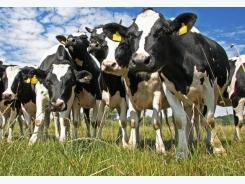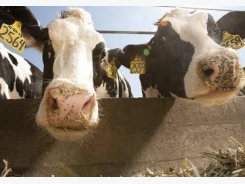Dont play guessing game: Know cows bodyweight

"Eyeballing" dairy cows to estimate bodyweight risks providing too high or low a dose of antibiotics
Antibiotic dosages are determined by individual cattle bodyweight, Dr. Richard Wallace, managing veterinarian, Dairy Technical Services with Zoetis, said in a "Dairy Wellness Quick Tip."
Zoetis defines “responsible use of antibiotics” as administering medication under the guidance of a veterinarian, following the directions on the approved product label and using only the amount needed to treat the problem, Wallace said. Therefore, use antibiotics responsibly and only when factoring in the appropriate dosage based on the accurate, individual bodyweight of dairy cows.
Dairies commonly determine antibiotic dosage based on visual estimates of weight for large and small cows, Wallace said. "Generally speaking, a large cow is a large cow; however, this practice of 'eyeballing' presents a big risk in under- or overdosing of antibiotics, as doses vary greatly given differences in bodyweight," he warned. "For example, recommended antibiotic dosage differs for a 1,500 lb. cow versus an 1,800 lb. cow."
Although first-lactation cows should have fairly uniform bodyweights, differences of more than 600 lb. in fresh heifer bodyweights have been recorded on a dairy with a scale, and the spread can be even greater with older cows, Wallace noted.
Without capturing accurate, individual bodyweights, cattle may be under-dosed, which can decrease antibiotic efficacy or create poor response to treatment, Wallace explained, which can result in increased treatment and labor costs due to disease relapse. Furthermore, dairies may be at increased risk for residues if other antibiotics are introduced and Food & Drug Administration-mandated withdrawal times aren’t followed.
On the other hand, Wallace said overdosing cows with antibiotics increases the risk of violative residues in milk and meat and increases treatment costs, since more product is being used than is needed. Keep in mind that overdosing isn’t just administering too much of a product; cows also can be overdosed based on the volume of antibiotic administered per injection site, he added.
Wallace provided the following tips for dairy operators:
1. Stop guessing.
2. Capture individual weights with a weight tape or digital cattle scale.
3. Weigh cows at freshening, one month post-calving and at dry-off to monitor for weight fluctuations that could indicate potential metabolic issues that may require treatment.
4. Follow product labels.
"Through responsible use of antibiotics, we all can help maintain the effectiveness of these important resources. Accurate bodyweight data allow for more accurate antibiotic dosing, resulting in improved treatment efficacy and prevention of residues in milk and meat," Wallace said, noting that producers should speak with their herd veterinarian for more suggestions.
Related news
Tools

Phối trộn thức ăn chăn nuôi

Pha dung dịch thủy canh

Định mức cho tôm ăn

Phối trộn phân bón NPK

Xác định tỷ lệ tôm sống

Chuyển đổi đơn vị phân bón

Xác định công suất sục khí

Chuyển đổi đơn vị tôm

Tính diện tích nhà kính

Tính thể tích ao



 Artificial insemination: ideal for communal farmers
Artificial insemination: ideal for communal farmers  6 Differences Between Llamas and Alpacas
6 Differences Between Llamas and Alpacas